Implementing support for the new version 8.0 of the Remote Desktop Protocol (RDP) for Windows 7 SP1. Even less known is the fact that after installing this update, RDP8 does not activate by itself and requires additional manipulations.
Activation
You need to start RDP8 support as follows:
- Open Group Policy – “gpedit.msc” in “Start” -> “Run…”.
- Enable the following setting:
English version: Computer Configuration -> Administrative Templates -> Windows Components -> Remote Desktop Services -> Remote Session Environment -> Enable Remote Desktop Protocol 8.0.
Russian version: Computer Configuration -> Administrative Templates -> Windows Components -> Remote Desktop Services -> Remote Desktop Session Host -> Remote Session Environment -> Allow Remote Desktop Protocol 8.0. - To restart a computer
Bugs
Of course, this was not without problems. After activating RDP8.0, you may find that you can no longer connect remotely, because. the absurd message “The connection was denied because the user account is not authorized for remote login.” (“The connection was denied because the user account does not have permission to log on remotely.”). Open "Control Panel" -> "System" -> "Remote Access Settings", and there - "Select Users".
The displayed window tells us in plain text that all computer administrators have access to the remote desktop by default, including the current user. However, this is a blatant lie. Click the “Add” button, and in the menu that opens, enter your username, click “Check Names” and save this entry.
Only after that we will be able to remotely connect to the system under this account.
Advantages
A short list of new features of RDP8 is presented at the link at the very beginning of this note. On my own behalf, I can only add that the idiot's dream has finally come true and now, when 3D applications are launched from an RDP session, they are displayed not as a slideshow, but noticeably more lively. With a static or not very rapidly changing picture, now the possibility of using them has become almost tangible. Not slowing down Ragnarok Online via RDP, a new miracle of the universe!
And you can also run a video player on a remote desktop and it will also output video with virtually no lags and brakes. That's just the sound for some reason noticeably out of sync.
disadvantages
On server editions of operating systems, one could find lamentable reviews that the shadow command no longer works in RDP8, which allowed switching to another user's desktop display without disabling it with several simultaneous connections to the system.
Also, the disadvantages include the inability to activate the Aero-Glass effect in a remote session. However, as it became known earlier, the ability to see the Aero effect was possible only when connected to a host with a Windows 7 Ultimate class operating system, while on the Professional edition this feature was blocked in any scenario and from any version of RDP, so switching to RDP8 we we don't lose anything.
Find out if it's involved RDP protocol 8, you can click on the small button displayed in the top panel of the remote desktop when it is expanded to full screen. The button is called “Connection Info” and displays a small menu with detailed information about the quality of the connection to the remote computer. The only inscription that I could see there is a line informing that the connection is “excellent”. And that's it. Regardless of the communication line, the remoteness of the host computer, etc…
Many users of modern computer and mobile systems would like to control their home terminals from a different location. But how to do it, because you can’t pull the cable connected to your home computer? This problem is designed to be solved by the so-called RDP clients, which provide communication between any computer and mobile devices through the Internet.
Dealing with their settings is a simple matter. But the question of what to prefer to get high-quality communication remains open for many users. Consider several options for the two most popular and common operating systems - Windows and Mac OS X.
RDP clients: what are they and what are they for?
The abbreviation RDP itself comes from the English phrase Remote Desktop, which literally means “remote desktop”. However, this name does not fully reflect all the possibilities of programs of this type.
By and large, any RDP client for Windows or any other operating system, including mobile OS, allows you to get full access to the intended terminal. In other words, it is impossible to say only that the user, when connected, can see only the "Desktop". With the necessary settings, he can remotely control the computer, installed programs, files and system settings, listen to music, watch videos, etc. It turns out that when sitting in front of another computer or looking at the screen of a mobile device, the user is actually in front of his own home (or work) terminal.
How is the connection made?
Now a few words about how the RDP client works for Windows 7 or other systems. Typically, the default for remote terminal access is the ITU T.120 protocol family, ports 3389 for TCP and 443 for HTTPS.
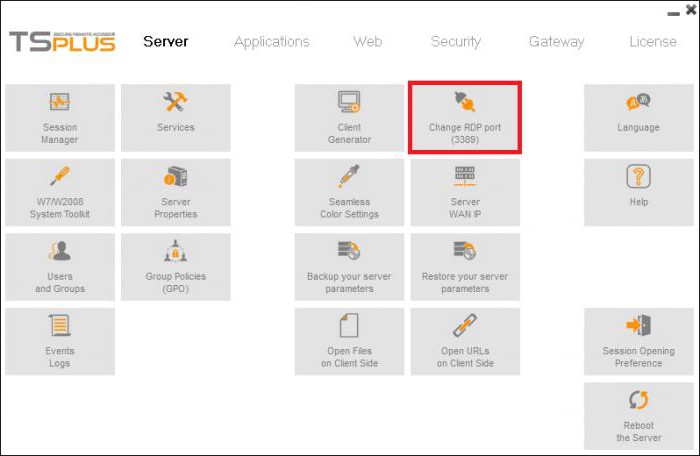
In order not to delve into technical details, the operation of such programs can be explained much more simply. RDP clients respond to events produced on the computer from which access is made (keystrokes on the keyboard, mouse actions, etc.), after which they are transmitted through their own driver to similar devices on the remote terminal, and then, again, when using their own video driver, display the content on the screen and send packets back to the RDC client (the terminal from which the control is carried out).
Issues with using the built-in or updated RDP client in Windows XP
Since the Windows version of XP is hopelessly outdated, although it is still quite popular among users, everything is not so simple with its built-in client.
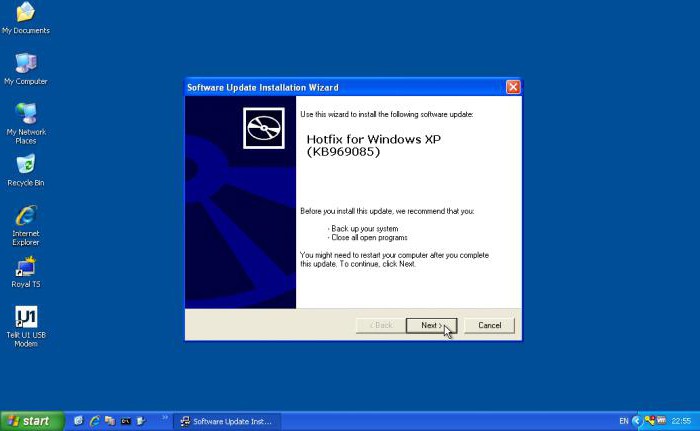
Even the third service pack uses the RDP client for Windows XP version 6.1. To get normal control, you need to install modification 7.0, and only manually. When downloading updates from the official Microsoft resource, problems can often be observed. Therefore, you should use another (verified) source to download updates KB969085 and KB969084, and then install them on the system (these are the so-called fixers or fixers for problems with connecting via RDP). Only after that, the "native" updated RDP client for Windows XP will work as expected. Connection problems are usually not observed.
Built-in RDP client for Windows 7
There are no problems with Windows 7. The system itself already has an updated RDP client 7.1 installed, for which the MsTsc.exe utility is responsible.
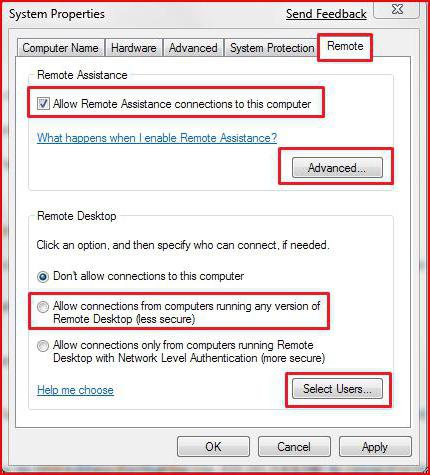
To establish a connection, first select the system section in the "Control Panel" and on the remote access settings tab, the lines for allowing connection to this computer and using Remote Assistance. As additional settings, you can select only those users who will have rights to connect to this terminal.
Alternative programs for Windows platforms
However, despite the presence of built-in remote connection tools in Windows systems themselves, many users prefer to use third-party software products.
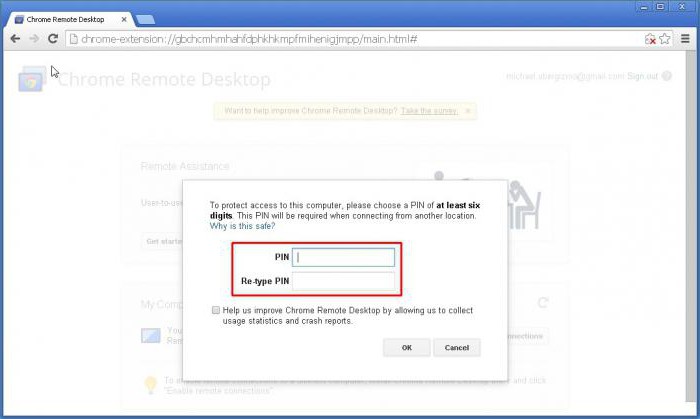
As an alternative, most recommend using RDP clients like Google's Chrome RDP, RDesktop, FreeRDP, Remmina, and many others. But if everything is simple with the latest programs, then for Chrome on the child terminal, you must have an installed browser of the same name, and on the terminal or mobile device - the corresponding RDP program for remote connection. On the other hand, if all conditions are met, then the default settings can be left unchanged. To establish a connection on a child computer, the connection permission is first activated, which creates a special PIN code, which will then need to be entered on the device from which it is supposed to be controlled.
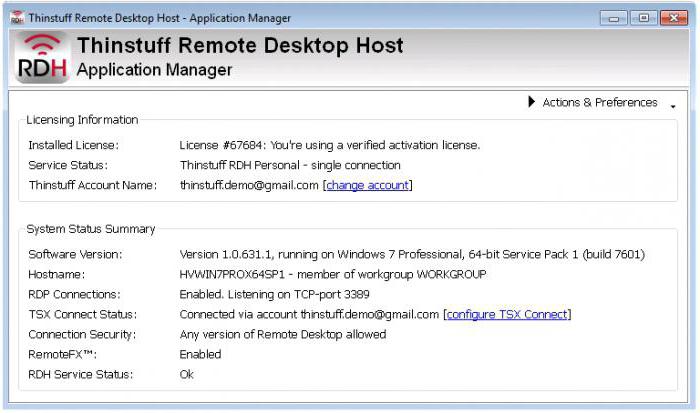
If someone does not like this approach, you can use other programs. So, for example, user reviews on the Web indicate that CITRIX can be a good option. Also, many people note that to create a terminal server based on RDP, a good solution is to install Thinstuff along with thin clients and WTware. At the same time, they even talk about saving traffic.
The most popular programs for Mac OS X
It goes without saying that in "apple" systems such software solutions are also used.
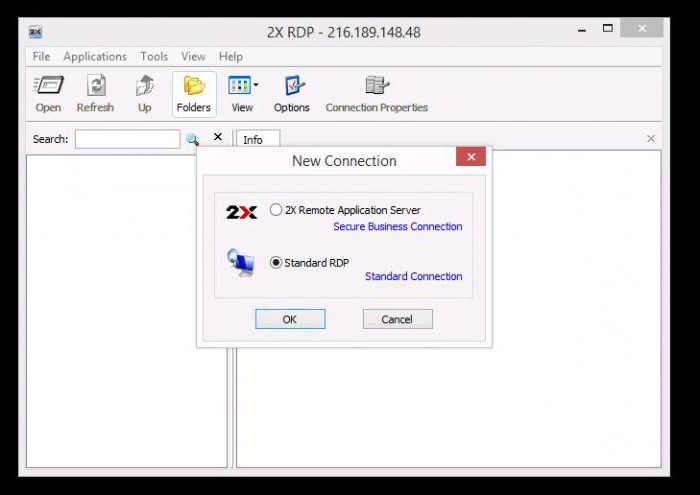
Among the most widely used and popular are the following client programs:
- Remote Desktop Connection - RDP client for Mac from Microsoft (works only with a good communication channel, and sometimes "crashes" when connecting / disconnecting due to the use of "hot" keys);
- CorD is a simple and stable free utility (the only drawback is that sometimes the cursor may disappear from the screen);
- 2X Client RDP - an application designed exclusively for "poppies" with a stable connection and support for SSL authorization;
- iTeleport is a unique program of its kind that allows you to access Mac computers when connected from Windows terminals;
- RDP Business Pro - a universal client with the ability to print to network printers and share folders and files;
- Jump RDP - client with VNC support;
- iTap Mobile - a mobile version of the client with the ability to work with RDP 7.1 (minus - a shareware version with a trial period of 15 days).
General setup questions
As for the settings of most programs, in comparison with Windows, they are simple, and all the user's participation is only to select the remote terminal that needs to be controlled.
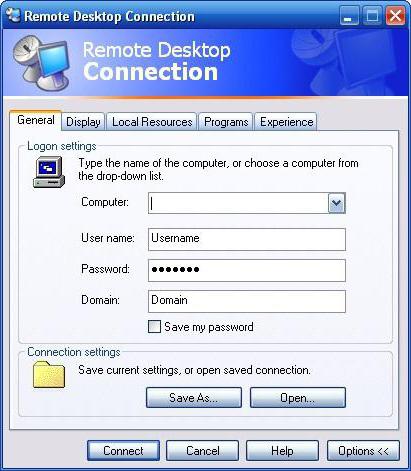
In Windows systems, to get to the connection, you need to use the “Run” console, in which the mstsc line is written, after which the IP of the terminal or server is indicated in the connection setup window, then personal data is entered, and only after that is redirected to the remote “Working table". Uncomfortable.
In addition, for a normal connection in the registry, you need to find the MinSendInterval parameter and assign it a value of 5-10 ms, and use the value 1 ms for the OrderDrawThreshold parameter.
If something is not working on Windows, you may need to make an exception in the firewall by creating a new rule for port 3389. And in some cases, port forwarding on the router may be necessary.
Instead of total
That's all in a nutshell about RDP clients for Windows and Mac OS X systems. Many people find the built-in tools too complicated to use, which is why such users prefer to use third-party programs. What do you recommend from all this? It seems that Chrome will still be the best option for Windows systems, despite the prerequisite for installing the web browser of the same name. For “poppies”, clients look more preferable, specially “sharpened” for them (for example, 2X Client RDP). But for cases of cross-communication between these systems, you will have to turn to the iTeleport utility for help.
Among users, quite a lot of people have heard that there is a certain RDP client.
But few people know what it is, why it is needed and how to work with it.
But in fact, this is simply an indispensable thing for those who need to work in several places, but there is no way to carry a laptop with them.
Why RDP is needed
Imagine that you work in an office. Your responsibilities include scheduling, paperwork, and more. You perform all these tasks on your computer in the office. But the work day ends, the guard says that he will close the room and you can’t stay in it, and you still need to complete several important tasks. And you can't put it off until tomorrow.
And at this moment this same RDP comes to the rescue. Imagine being able to come home, turn on your home computer, and continue to work on the same desktop and with the same data as on your work computer. That is, being at home, you will, in fact, work on a work computer.
Rice. 1. RDP allows you to work from one computer to another
Interesting?
Then we continue!
Decrypt RDP
RDP is a remote desktop protocol. This is the definition given in official sources. This abbreviation stands for "Remote Desktop Protocol". Actually, this is translated as the remote desktop protocol.
There is no complex science here. This protocol is really designed to work with the desktop remotely. This means that you are at a certain distance from where the desktop actually is, and at the same time have the opportunity to work with it.
Actually, the RDP client is a program that allows you to implement the functions of this very protocol. In other words, this is a program that gives the user the ability to work with a computer remotely. You can quite easily organize access to your computer, then connect to it from another device and continue to work. In fact, there is nothing complicated about this.
Rice. 2. Remote access to a computer from a tablet
Today, RDP clients exist on a wide variety of operating systems, including:
- windows;
- MacOS;
- android;
Users of all these platforms have the opportunity to organize remote access to their devices quite calmly. Moreover, from a device on one OS, you can do the same for a device on another. For example, you can connect to a Windows computer from an Android tablet.
In general, a very useful and interesting feature. And now we will look at how to work with this protocol and programs for working with it.
RDP client on Windows
The earliest and most common example of a remote access protocol program is the Remote Desktop Connection tool for Windows. Actually, the RDP protocol was developed for this operating system. And only then it began to be used in other operating systems.
To date, in any version of Windows there is a built-in tool called "Remote Desktop Connection". It can be found in the start menu or by searching. It's called the same everywhere.
To use it, you must first set up the computer to which you will connect, that is, the desktop of which you are going to work. To do this, do this:
- First you need to find out the IP address of the computer, in order to then give it to another device, from which the first one will be controlled. To do this, follow these steps:
- launch the program execution window by simultaneously pressing the Win and R buttons on the keyboard;
- in the window that opens, in the only input field, enter "cmd" and press Enter on the keyboard - thus you will launch the command line;
Rice. 3. Command to launch the command line in the program execution window
- at the command prompt, type the command "ipconfig" and press Enter again;
- all available network information will open, find the line “IPv4 address” there - opposite it will be the IP address, remember it (!).
Rice. 4. Network information on the command line
As you can see, in our example, the IP address is 192.168.1.88.
- Now you should enable the ability to access the computer using the remote management tool. To do this, do the following:
- in the "Start" menu, open the "Control Panel";
- click on the "System and Security" section;
Rice. 5. Section "System and Security" in the control panel
- in the next window, click on the "System" subsection;
Rice. 6. Subsection "System"
- in the menu on the left, select "Advanced system settings";
- in the window that opens, go to the "Remote Access" tab;
- put a checkmark in front of the items marked in Figure 7 by numbers 1 and 2;
- close all windows, and before that, click "Apply".
Rice. 7. Allow remote control in the "System" section
Now you can safely connect to this computer. This operation is also very simple. It is performed in the following sequence:
- Go to the "Start" menu, select the list of all programs there, then the "Accessories" section and click on the tool called "Remote Desktop Connection". It won't be hard to find him.
Rice. 8. Remote Desktop Connection Tool in Start Menu
- Next, in the next window, you need to enter the IP address that we determined in one of the previous steps. Recall that in our example it is 168.1.88. This address must be entered in this very window. When this is done, proceed to the next step, but do not click the "Connect" button yet. Instead, click on the inscription "Options", which is located a little lower and to the left of the address entry field.
Rice. 9. Remote Desktop Connection Tool Window
- It is important that you are able to work not only with folders and files, but also with devices connected to the computer that will be managed. Therefore, in the window that pops up, go to the "Local Resources" tab and check the boxes next to the "Printers" and "Clipboard" items. Now you can click the "Connect" button and, thus, proceed to the next step.
Rice. 10. Settings for connecting to a remote computer
After that, a connection will be made to the specified computer at its address. Some install an account system on their devices. In this case, you will need to enter a username and password to connect. But if at the first stage of the setup described above you did nothing to install such a system, you do not need to enter anything.
Everything is simple! Is not it?
Now you know how to use the simplest version of RDP and you can easily establish a remote connection. If you have any questions or difficulties, write about it in the comments below. We will definitely answer.
Among users, quite a lot of people have heard that there is a certain RDP client.
But few people know what it is, why it is needed and how to work with it.
But in fact, this is simply an indispensable thing for those who need to work in several places, but there is no way to carry a laptop with them.
Content:Why RDP is needed
Imagine that you work in an office. Your responsibilities include paperwork and more. You perform all these tasks on your computer in the office. But the work day ends, the guard says that he will close the room and you can’t stay in it, and you still need to complete several important tasks. And you can't put it off until tomorrow.
And at this moment this same RDP comes to the rescue. Imagine being able to come home, turn on your home computer, and continue to work on the same desktop and with the same data as on your work computer. That is, being at home, you will, in fact, work on a work computer.
Interesting?
Then we continue!
Decrypt RDP
RDP is a remote desktop protocol. This is the definition given in official sources. This abbreviation stands for "Remote Desktop Protocol". Actually, this is translated as the remote desktop protocol.
There is no complex science here. This protocol is really designed to work with the desktop remotely. This means that you are at a certain distance from where the desktop actually is, and at the same time have the opportunity to work with it.
Actually, the RDP client is a program that allows you to implement the functions of this very protocol. In other words, it is a program that gives the user the ability to . You can quite easily organize access to your computer, then connect to it from another device and continue to work. In fact, there is nothing complicated about this.

Rice. 2. Remote access to a computer from a tablet
Today, RDP clients exist on a wide variety of operating systems, including:
- windows;
- MacOS;
- android;
Users of all these platforms have the opportunity to organize remote access to their devices quite calmly. Moreover, from a device on one OS, you can do the same for a device on another. For example, you can connect to a computer on Windows.
In general, a very useful and interesting feature. And now we will look at how to work with this protocol and programs for working with it.
RDP client on Windows
The very first and most common example of a program for working with a remote access protocol is a tool for connecting to. Actually, the RDP protocol was developed for this operating system. And only then it began to be used in other operating systems.
To date, in any version of Windows there is a built-in tool called . It can be found in the start menu or by searching. It's called the same everywhere.
To use it, you must first set up the computer to which you will connect, that is, the desktop of which you are going to work. To do this, do this:
- First you need to know the computer, then to give it to another device, from which the first one will be controlled. To do this, follow these steps:
- launch the program execution window by simultaneously pressing the Win and R buttons on the keyboard;
- in the window that opens, in the only input field, enter "cmd" and press Enter on the keyboard - thereby you;

Rice. 3. Command to launch the command line in the program execution window
- at the command prompt, type the command "ipconfig" and press Enter again;
- all available network information will open, find the line “IPv4 address” there - opposite it will be the IP address, remember it (!).
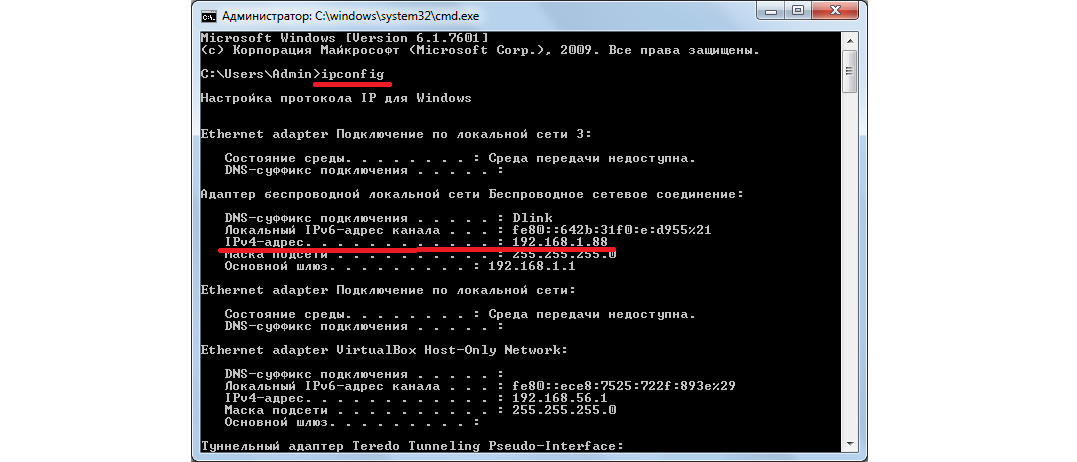
Rice. 4. Network information on the command line
As you can see, in our example, the IP address is 192.168.1.88.
- Now you should enable the ability to access the computer using the remote management tool. To do this, do the following:
- in the start menu open "Control Panel";
- click on section "System and safety";
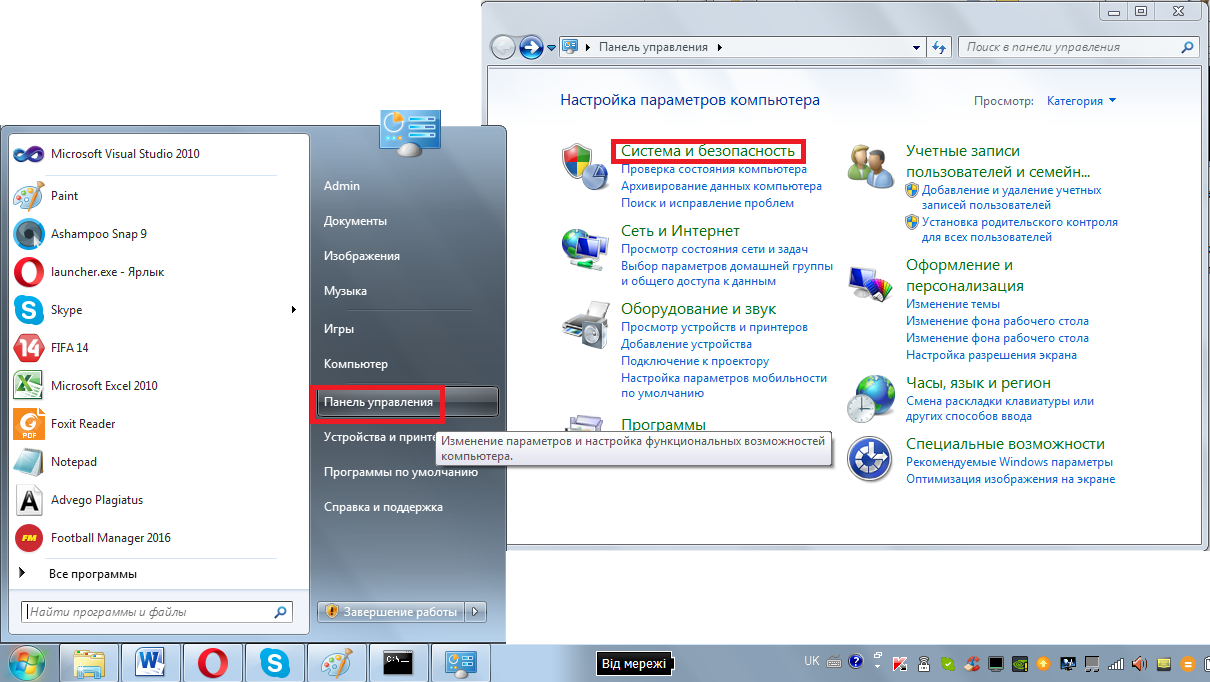
Rice. 5. Section "System and Security" in the control panel
- in the next window, click on the subsection "System";
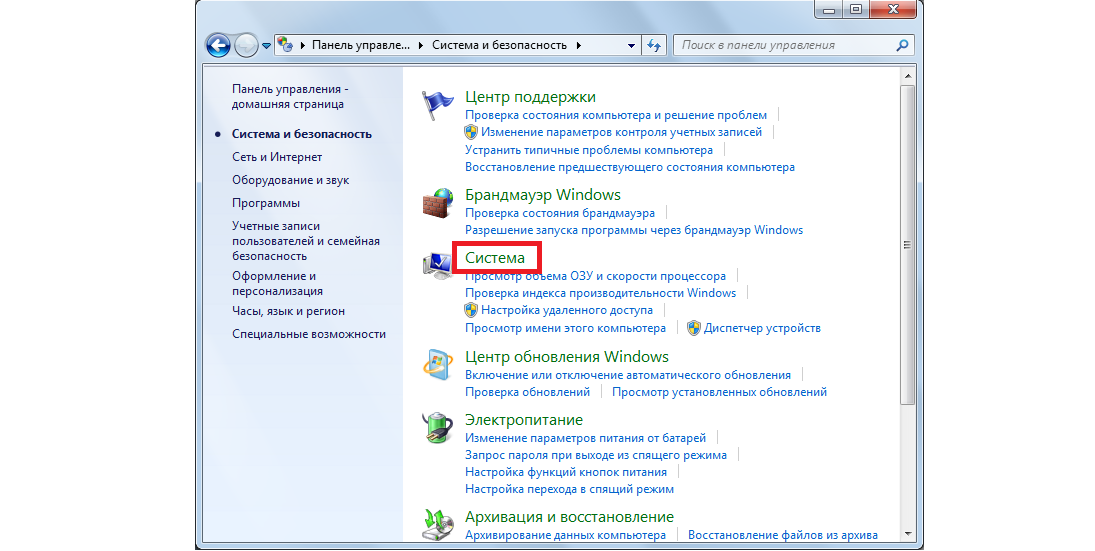
Rice. 6. Subsection "System"
- select from the menu on the left "Advanced system settings»;
- in the window that opens, go to the tab "Remote access";
- put a checkmark in front of the items marked in Figure 7 by numbers 1 and 2;
- close all windows, and before that click "Apply".
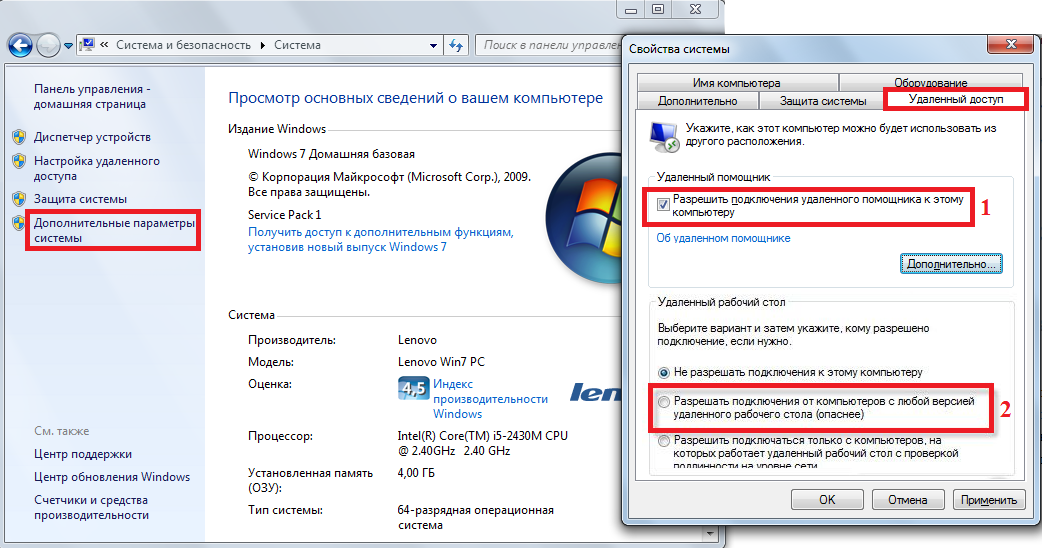
Rice. 7. Allow remote control in the "System" section
Now you can safely connect to this computer. This operation is also very simple. It is performed in the following sequence:
- Go to the "Start" menu, select the list of all programs there, then the "Accessories" section and click on the tool called "Remote Desktop Connection". It won't be hard to find him.
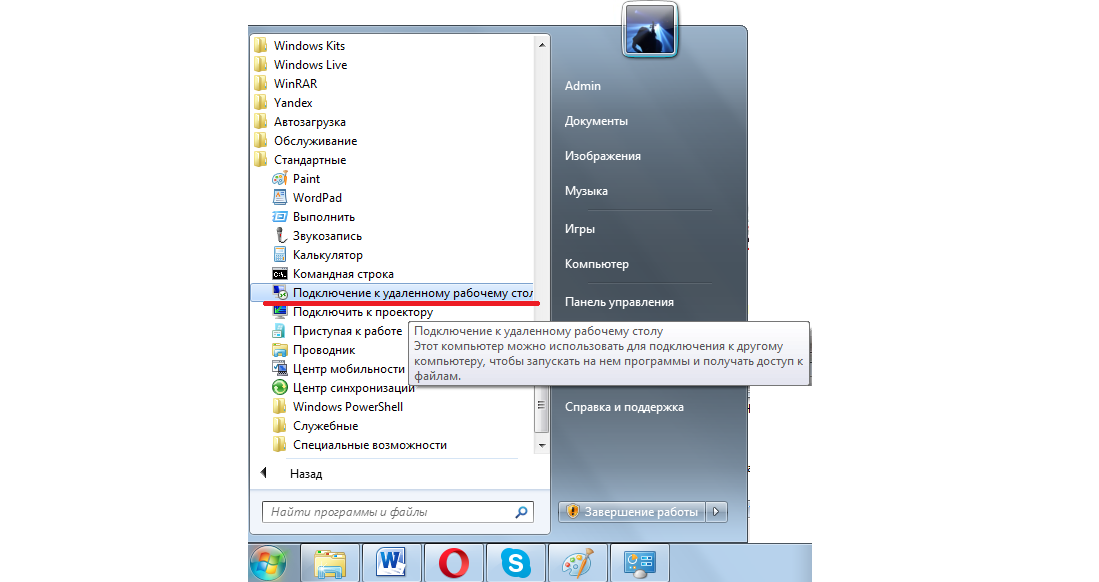
Rice. 8. Remote Desktop Connection Tool in Start Menu
- Next, in the next window, you need to enter the IP address that we determined in one of the previous steps. Recall that in our example it is 168.1.88. This address must be entered in this very window. When this is done, proceed to the next step, but do not press the " Connect" button yet. Instead, click on the inscription "Options", which is located a little lower and to the left of the address entry field.

Rice. 9. Remote Desktop Connection Tool Window
- It is important that you are able to work not only with folders and files, but also with devices connected to the computer that will be managed. Therefore, in the pop-up window, go to the tab "Local Resources" and check the boxes next to the items "Printers" and "Clipboard". Now you can click the "Connect" button and, thus, proceed to the next step.
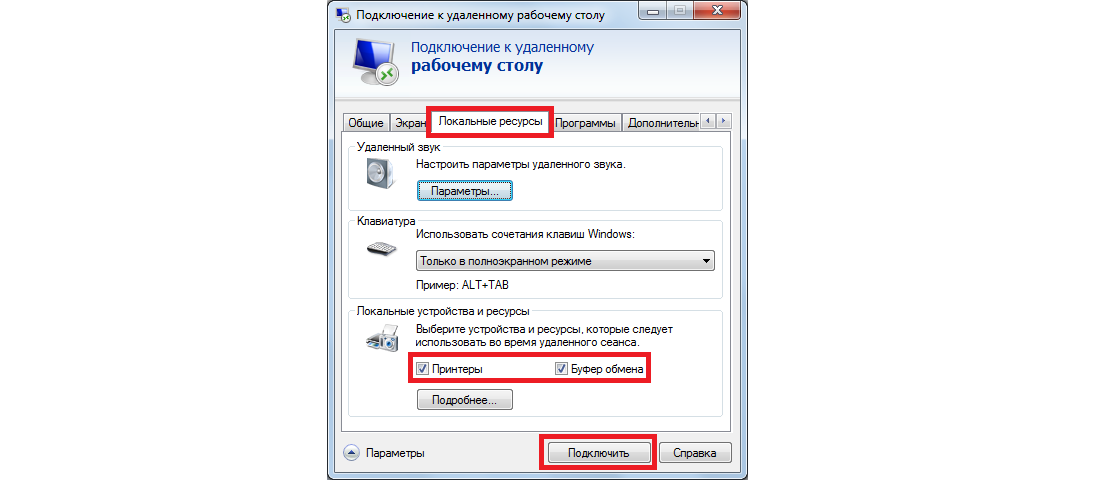
Rice. 10. Settings for connecting to a remote computer
After that, a connection will be made to the specified computer at its address. Some install an account system on their devices. In this case, you will need to enter a username and password to connect. But if at the first stage of the setup described above you did nothing to install such a system, you do not need to enter anything.
Everything is simple! Is not it?
Now you know how to use the simplest version of RDP and you can easily establish a remote connection. If you have any questions or difficulties, write about it in the comments below. We will definitely answer.
In the meantime, for a deeper understanding of the issue, let's consider some other programs that work as RDP clients, that is, they allow you to remotely control your computer.
